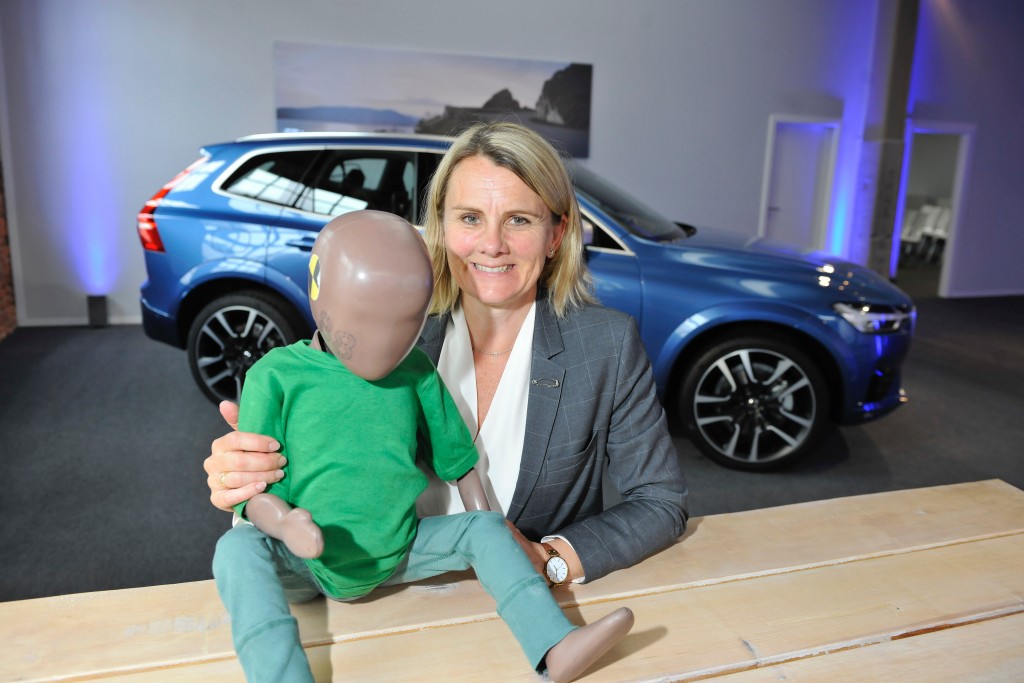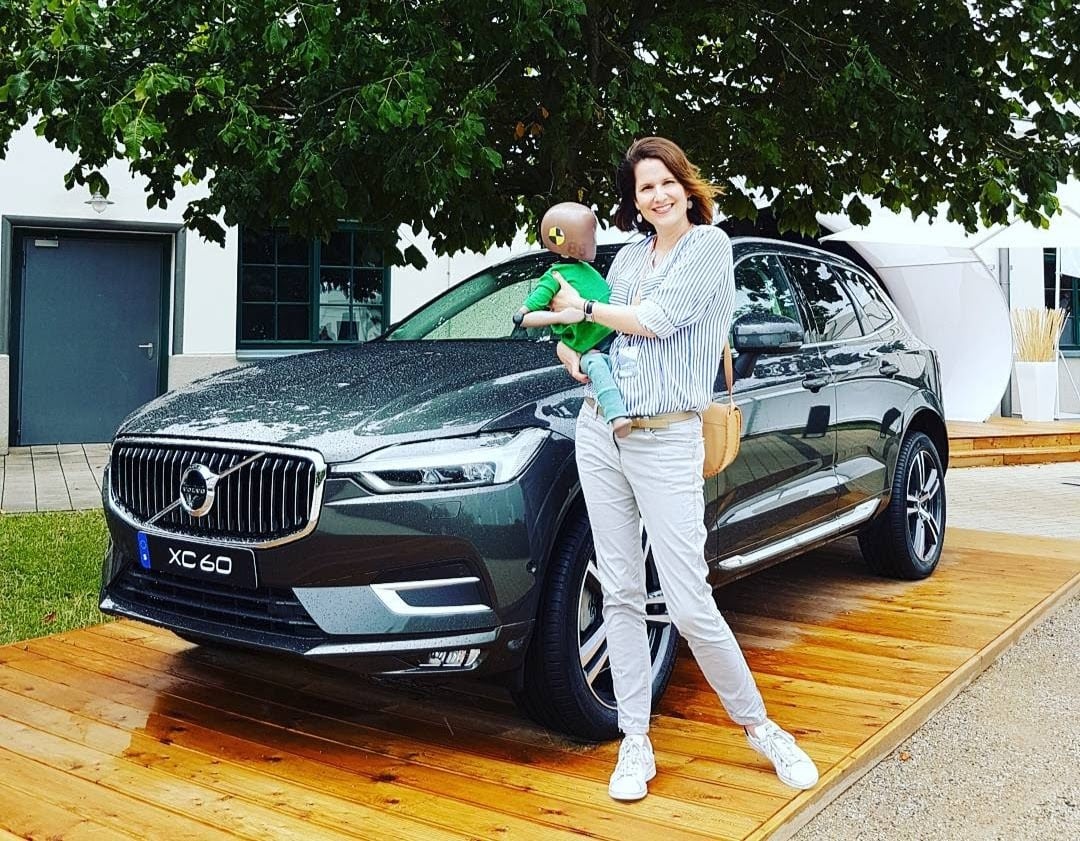Warum der Kindersitz im Auto nach hinten gerichtet sein sollte, darum geht es im heutigen Blogpost. Auf einer Pressereise, zu der ich von Volvo eingeladen wurde, hatte ich Gelegenheit mit Lotta Jakobsson, Senior Technical Leader Safety bei Volvo, sprechen zu dürfen.
Was ich bisher nicht wußte: Ob man den Kindersitz nach hinten richtet oder nach vorne, das macht einen erheblichen Sicherheitsunterscheid im Falle eines Unfalls aus. Tatsächlich sollten Kinder so lange wie möglich im Kindersitz nach hinten gerichtet im Auto sitzen. Da gibt es in Deutschland tatsächlich eine Sicherheitslücke zu schließen und das habe ich damals mit meinen Kindern auch falsch gemacht. Die wurden nämlich sehr früh in ihrem Maxi Cosi in Fahrtrichtung positioniert.
Übrigens durften wir auf dieser Reise den neuen Volvo XC60 Probe fahren. Für mich als Schweden Fan und Volvo-Besitzerin seit 10 Jahren ein großartiges Erlebnis. Über dieses schöne Auto geht es aber in diesem Beitrag nicht, sondern um Kindersicherhit und welche Vision zum Thema Verkehrssicherheit Volvo hierzu entwickelt hat.
Warum der Kindersitz im Auto nach hinten gerichtet sein sollte: Experteninterview mit Lotta Jaokobsson
Hier in Deutschland ist dieser Aspekt noch nicht so geläufig. Warum sind rückwärts gerichtete Kindersitze so viel sicherer als vorwärts gerichtete? Gibt es dazu ein paar Fakten?
Small children have relatively larger heads as compared to older children. The neck bones and muscles develop and get significantly stronger over the first years. In a frontal impact (which is the most frequent and severe type of accident), the child needs to face rearward so the forces are distributed over the head and back, minimizing the forces in the neck. When a child is facing forward, the only thing restraining the head in a frontal impact is the neck, so the child needs to reach a strength and maturity to cope with that.
We recommend rearward facing up to 3-4 years of age. At that stage, the neck shape has been modified to more saddle shaped vertebrae, which together with the muscles can cope with higher forces. Comparing crash tests, multiple times higher loads are measured in the neck for the forward facing crash test dummy as compared to the rearward facing illustrating this. Unfortunately, neck forces are not measured in certification (type-approval) tests of child seat when E-approved, which is the main reason that forward facing seats can be sold to 1 year olds. A change with the new I-size regulation mandates that children must go rearward facing up to 15 months old, in the seats approved according to the new regulation.
In Sweden since the 1970:ies, children travel rearward facing up to at least age 2.
Wir alle schnallen unsere Kinder beim Autofahren an und benutzen Kindersitze. Warum ist es so wichtig, hier auf die richtige Anwendung zu achten?
Children are different in size and maturity. For the smallest, the neck is the highest priority, there they need to go rearward facing. When strong enough to go forward facing (we recommend 3 preferably 4 years old), they need to have restraints that distribute the forces where the body is strongest. These body regions are the hip-bone and the chest/shoulder. In order to fit into the vehicle three point belt, they need to be raised in position so that the lap belt is routed over the strong hip bone and not over the soft belly.
This will then also help the shoulder to more comfortably position over the chest and shoulder. Always aim for a mid-shoulder position of the shoulder belt. If too far out on the shoulder it will not restrain the child properly. Never place the belt under the arm or behind the back. It will not harm the child if it is close to the neck, however it will likely be uncomfortable making the child to move it away.
If the parent focuses on that the belt is nicely positioned over the hip-bone and across the chest and mid-shoulder, it will help him/her to choose and use a booster cushion or booster seat correctly. Depending on the car and the booster type/model different fitments will be seen, however if one always strive for the good belt fit the focus will be right.
When the child has reached 150cm it is allowed, according to German law, to use the seatbelt only. Until then a booster is required. For the oldest, a booster cushion (without the backrest) is usually the best choice, while the smallest usually need a booster seat (with backrest and side supports) to sit more upright in a good seatbelt position.

Frau Jakobsson, Volvo hat eine sehr anspruchsvolle Vision für die Zukunft entwickelt. „Ab dem Jahr 2020 soll niemand mehr in einem Volvo getötet oder schwer verletzt werden“. Wie wollen sie das umsetzen, denn es fahren ja immer noch Menschen die Autos, oder?
Our safety vision states the mindset of how we work with safety at Volvo Cars. Our ambition is to address everyone based on the needs of the individual and the situation. We develop our cars accordingly and based on knowledge that we gather and develop. Since 1970 we have collected real world crashes with Volvo cars in a continuous way.
Based on real world data we understand the needs for protection and we take action accordingly. This includes assisting the driver when driving, correcting when close to a crash (e.g. autobrake) and protecting in case the crash is unavoidable.
Warum ist das Thema Sicherheit traditionell so wichtig für Volvo?
Already our founders (1927) stated that since cars are driven by people, people should be in focus for what we do. We have worked in line with this since then, pioneering with three point seatbelts as standard equipment in 1959 and continued with developing and introduced safety innovations ever since. Based on the real world data we collect and analyze, we set out our own path of development.
Volvo ist ein Pionier in Sachen Kindersicherheit im Auto. Was ist hier Ihr Hauptanliegen?
Volvo was a part from the very beginning. We performed the crash testing of the very first child seat for safety. Professor Bertil Aldman at Chalmers University in Gothenburg was inspired by the way astronauts were launched in space and experimented with a rearward facing seat concept in 1964. Three years later this became the very first child seat addressing protection of children in cars. Volvo was first OEM to make a child seat in 1972 and we have had a child seat program ever since. The first generation seats accommodated children up to 6-7 years rearward facing.
It wasn’t until 1978, the booster to be used together the seat belt came into the market. This was a Volvo invention and it was developed based on knowledge from the real world data. We continued this development introducing integrated (built-in) boosters in 1990 and in 2007 we took the integrated booster a step further, making it in a 2 stage design addressing the needs of the growing child. This exemplifies our ambitions in the area child safety, addressing the protection needs as well as ease-of-use, comfort and attractiveness.
Child safety is important for us at Volvo, simply because children are important as well as a part of the occupants in a Volvo car. Since they have specific needs, their protection needs to be addressed somewhat different from adults.
Das Interview ist im Rahmen einer Pressereise entstanden.






Keine Kommentare